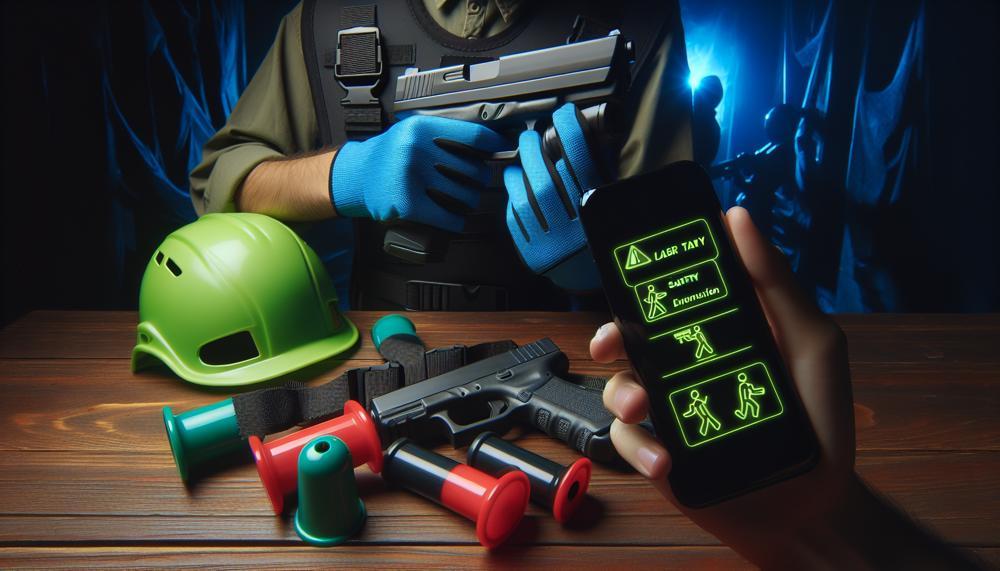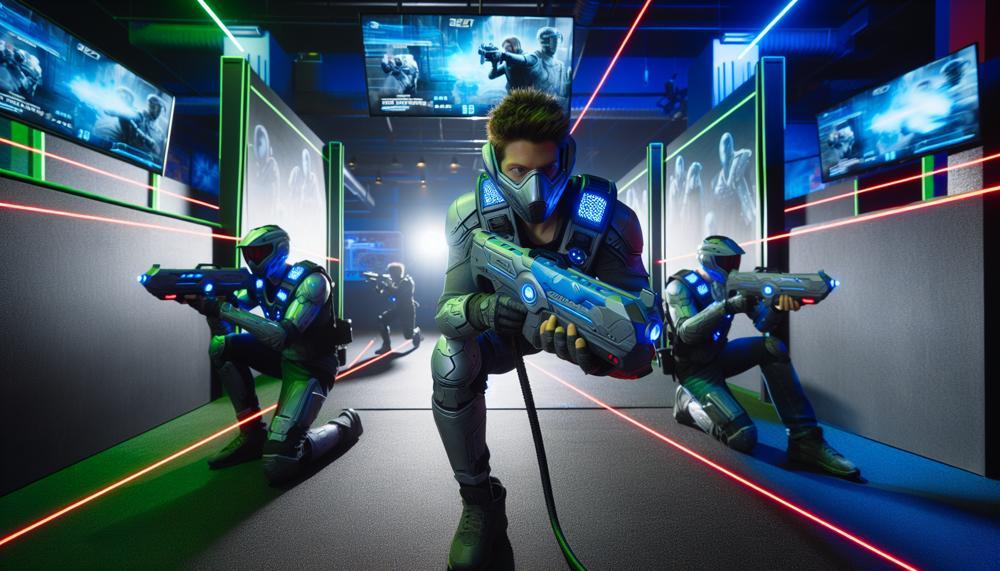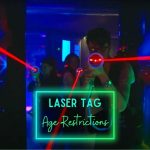Are you a laser tag enthusiast? Do you relish the adrenaline rush of navigating through a dimly lit arena, strategizing to outwit and outshoot your opponents with a laser gun? While it may seem like innocent fun, there are hidden dangers associated with this popular game.
Before suiting up for your next match, pause and consider these crucial points:
- Laser tag involves physical exertion and can result in injuries such as sprains, strains, and bruises.
- The use of lasers in the game can cause damage to the eyes if proper safety measures are not followed.
- The flashing lights and loud noises in the arena may cause disorientation or dizziness for some players.
- Poorly maintained equipment at certain laser tag facilities can increase the risk of accidents.
- Individuals with medical conditions such as epilepsy or heart problems may be triggered by the intense sensory stimulation of laser tag.
While these hazards may not dissuade you from playing laser tag altogether, it is essential to be mindful of them and take necessary precautions. In this blog post, we will delve deeper into these potential risks and offer valuable tips on how to stay safe while still enjoying this thrilling game.
So, grab your laser gun and join me as we explore the perils of playing laser tag.
Table of Contents
Can You Get Hurt Playing Laser Tag?
Laser tag is generally considered safe and painless. Laser tag guns use infrared technology and sensors instead of lasers to make them safe for adults and children. When a player is tagged, their equipment temporarily shuts down.
However, like any physical activity, there are risks involved. Some common injuries that can occur while playing laser tag include:
- Falling and twisting an ankle
- Accidentally being hit by another player
- Bruises from falling down
Some safety rules for laser tag include:
- No running
- No crouching, crawling, or lying down
- No wheelie/heeled footwear
- No physical contact
- No disrespectful, abusive, or threatening behavior
- No climbing on the scenery
Follow the rules

Playing laser tag is all about having a good time while staying safe. As with any game, following the rules is essential, and laser tag is no exception. These rules are in place to ensure fair play, prevent injuries and damage, enhance the gameplay experience, promote safety, avoid penalties, set a good example, and avoid potential risks.
- First and foremost, following the rules in laser tag ensures that all players have an equal chance to win and enjoy the game. It prevents unfair advantages and promotes a level playing field for all participants. By adhering to these rules, players can avoid any disputes or disagreements during the game.
- The rules in laser tag are designed to keep players safe and prevent any damage to equipment. By following these rules, players can avoid potential accidents and injuries. This not only protects the individuals playing but also ensures that the equipment remains in good condition for future games.
- Furthermore, laser tag involves shooting at opponents with a tagging gun, which can pose risks if not played safely. By following the rules, players can ensure that they and their fellow participants are safe from any potential harm. This includes wearing protective gear such as vests and goggles provided by the facility hosting the game.
- Not only does following the rules benefit individual players, but it also sets a good example for others to follow. It promotes a positive and respectful attitude towards the game, fellow players, and the facility hosting the game. This creates a more enjoyable and welcoming environment for everyone.
- Lastly, laser tag facilities have strict safety measures in place, but accidents can still happen if players do not follow the rules. By adhering to the rules, players can avoid any potential risks and ensure a safe and enjoyable experience for everyone. This includes being aware of the boundaries and rules specific to each facility.
No physical contact
The absence of physical contact in laser tag greatly reduces the chance of injury as it eliminates the possibility for direct physical contact between players. This is due to the unique nature of the game, where infrared light is used instead of actual lasers.
No Use of Actual Lasers:
One of the primary reasons why laser tag is a safer option compared to other physical games is because it does not involve the use of actual lasers.
Instead, it utilizes infrared light, similar to that found in TV remote controllers. This eliminates the risk of burns or eye injuries that may occur with other laser-based activities.
Compliance with Safety Standards:
Even laser tag systems that do utilize lasers strictly adhere to the safety standards set by the US FDA. This ensures that the lasers used in the game are completely safe for players and do not pose any risk of injury.
Reduced Physical Activity:
While there is still a possibility of injury from running and jumping during laser tag, the lack of physical contact significantly reduces overall physical activity in the game.
This means that players are less likely to experience common injuries such as sprains, strains, or muscle soreness.
Rare and Minor Injuries:
Injuries reported during laser tag are uncommon and mostly minor, such as tripping and falling.
This is primarily due to the lack of physical contact between players and the generally low-impact nature of the game.
Safety Guidelines:
To further minimize the risk of injury, players should follow safety guidelines such as wearing appropriate footwear and avoiding contact with others.
These guidelines are put in place to ensure safety and prevent any potential accidents or injuries.
Suitable for All Ages:
Due to its low-risk nature, laser tag is suitable for players of all ages. It provides a fun alternative to more physically demanding games while also promoting safety and minimizing potential injuries.
In conclusion, the absence of physical contact in laser tag greatly reduces the risk of injury for players.
No blocking sensors
Laser tag equipment is equipped with a crucial safety feature known as blocking sensors. These sensors, placed on the vests or guns used in the game, act as a barrier between players, ensuring that no physical contact occurs that could lead to injuries.
The functionality of these sensors is simple yet effective. They work by detecting and registering infrared signals from other players’ vests or guns. When a player’s sensor detects an incoming infrared beam, it temporarily deactivates, indicating that the player has been “tagged” and must temporarily sit out of the game. This system not only prevents physical contact but also promotes fair gameplay by accurately detecting when a player has been hit.
Additionally, blocking sensors also prevent any attempts at cheating by obstructing players from covering or tampering with them. This maintains the integrity of the game and ensures that all players have an equal chance of winning.
In addition to safety and fair play, blocking sensors also play a crucial role in fostering social interaction among players. With physical contact not allowed, players must rely on their strategic skills, teamwork, and communication to win the game. This creates an enjoyable and inclusive environment for players of all ages.
No bullying
In order to create a safe and inclusive environment for players, laser tag facilities must prioritize safety and promote respectful and disciplined behavior among participants.
Here are some essential steps that laser tag facilities can take to guarantee a secure and enjoyable experience for all players:
- Implement Safety Policies: Laser tag facilities should have clearly defined safety guidelines in place, including strict regulations against physical contact, running, and inappropriate conduct. These guidelines should be prominently displayed and strictly enforced by staff members to prevent any potential harm.
- Use Certified Equipment: Facilities should ensure that their equipment is properly certified and does not use real lasers or strong infrared beams. This will significantly reduce the risk of injuries and create a safe playing environment for all participants.
- Provide Protective Gear: Players should be provided with helmets that offer eye protection, especially in case of collisions or mishaps. This will prevent any potential eye injuries and safeguard players from accidental collisions.
- Promote Respectful Behavior: Laser tag facilities should have a zero-tolerance policy for bullying or any type of verbal or physical aggression towards other players. This will foster a positive and inclusive atmosphere for players to enjoy the game without fear of being bullied.
- Encourage Appropriate Attire: Players should be reminded to wear dark clothing and suitable protective gear according to the arena’s rules and regulations. This not only enhances the laser tag experience but also prevents any potential injuries.
Strictly, closed-toe shoes only
Laser tag demands agility, speed, and sometimes even crawling through obstacles. Wearing closed-toe shoes is an essential safety measure to ensure players have the necessary protection and grip to navigate the arena without accidents.
Sandals or flip-flops are not suitable for this type of activity and may result in being denied entry to play. Sneakers or sports shoes are highly recommended for their comfort and support during the fast-paced game.
It is important to note that most laser tag arenas have a strict dress code that requires players to wear closed-toe shoes. This rule is in place to ensure the safety of all participants and maintain a professional environment. Failure to comply with the dress code may result in being unable to participate in the game.
Aside from safety concerns, clothing choice can also affect gameplay. Light-colored clothes make players more visible in the dark arena, making them easier targets. On the other hand, darker colors such as black or navy blue act as camouflage, allowing players to blend in with their surroundings.
It is also crucial to avoid wearing any jewelry or accessories while playing laser tag. These items can be distracting and make it easier for opponents to spot players in the arena. It is best to dress in comfortable, athletic attire that allows for speedy movements and actions.
Furthermore, layering clothing is a useful tactic for laser tag players. The game can be physically demanding, and arenas may be chilly. By layering clothing, players can stay comfortable while still being able to remove layers during intense gameplay.
Lastly, for outdoor games, it is recommended to wear camouflaged or neutral light-colored clothing instead of dark colors. This tactic helps players blend in with their natural surroundings and adds an extra element of strategy to the game.
No food and drinks
When engaging in physical activities like laser tag, it’s important to stay hydrated and nourished. However, consuming food and drinks during gameplay can pose safety risks and negatively affect the overall experience. Therefore, it is not recommended to have food and drinks while playing laser tag.
Why is it unsafe? Firstly, there is a potential for choking or spilling food/drink while running and dodging obstacles during gameplay. This can not only cause harm to the player but also create a hazardous environment for others. Additionally, spilled drinks can make surfaces slippery, increasing the risk of accidents or injuries. Furthermore, consuming food and drinks can distract players from the game and reduce their focus on safety rules.
In terms of gameplay, holding onto snacks or drinks can slow down movement and reaction time, making players easier targets. It can also interfere with equipment such as tagging guns and vests, hindering their performance.
To avoid these issues, players should prioritize safety and gameplay over convenience. Instead of eating or drinking during the game, they can plan ahead and have a snack or hydrate before or after the game or during breaks between rounds. Bringing a small water bottle to keep nearby can also help prevent dehydration without compromising safety.
Conclusion
In conclusion, laser tag may appear to be a harmless and exhilarating game, but it comes with its own set of potential dangers.
From physical injuries to risks for those with underlying medical conditions, players must be cautious and take necessary precautions before jumping into the action. Adhering to facility rules, donning appropriate attire and protective gear, and avoiding distractions like food and drinks during gameplay are essential steps in ensuring a safe and enjoyable experience.
Stay vigilant, aim with precision, and constantly change tactics to outsmart your opponents in the dimly lit arena.






